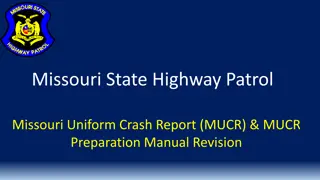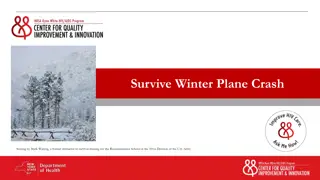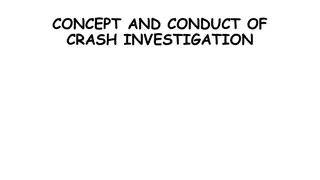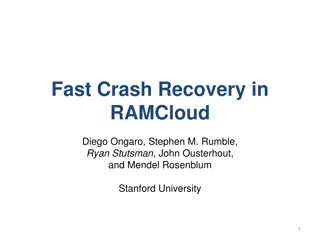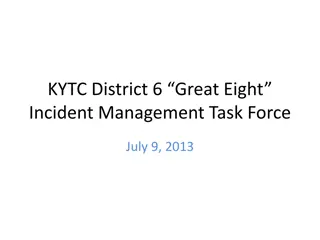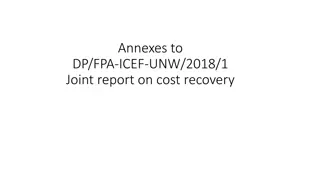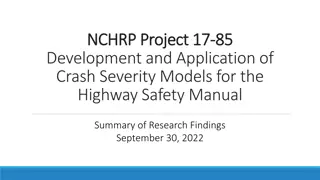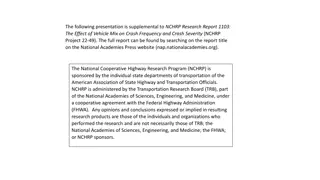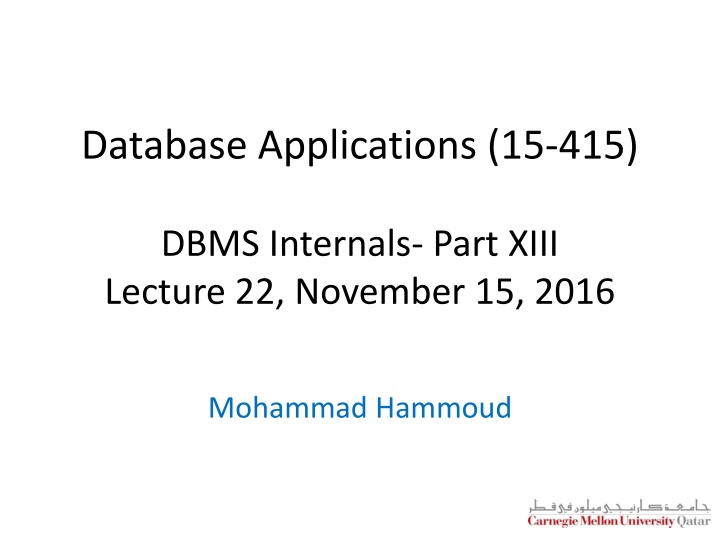
DBMS Internals and ACID Properties Overview
Explore the key aspects of Database Management Systems (DBMS) internals, focusing on transaction and recovery management. Learn about ACID properties - Atomicity, Consistency, Isolation, and Durability - and their role in ensuring data integrity and reliability in concurrent access scenarios and system failures.
Download Presentation

Please find below an Image/Link to download the presentation.
The content on the website is provided AS IS for your information and personal use only. It may not be sold, licensed, or shared on other websites without obtaining consent from the author. If you encounter any issues during the download, it is possible that the publisher has removed the file from their server.
You are allowed to download the files provided on this website for personal or commercial use, subject to the condition that they are used lawfully. All files are the property of their respective owners.
The content on the website is provided AS IS for your information and personal use only. It may not be sold, licensed, or shared on other websites without obtaining consent from the author.
E N D
Presentation Transcript
Database Applications (15-415) DBMS Internals- Part XIII Lecture 22, November 15, 2016 Mohammad Hammoud
Today Last Session: Transaction Management Today s Session: Recovery Management Announcement: PS4 is due on Nov 20
DBMS Layers Queries Query Optimization and Execution Relational Operators Files and Access Methods Transaction Manager Recovery Manager Buffer Management Lock Manager Disk Space Management DB
Outline The ACID Properties The Steal, No-Force Approach Logging and the WAL Protocol The Log
The ACID Properties Four properties must be ensured in the face of concurrent accesses and system failures: Atomicity: Either all actions of a transaction are carried out or none at all Consistency: Each transaction (run by itself with no concurrent execution) must preserve the consistency of the database Isolation: Execution of one transaction is isolated (or protected) from the effects of other concurrently running transactions Durability: If a transaction commits, its effects persist (even of the system crashes before all its changes are reflected on disk)
The ACID Properties Four properties must be ensured in the face of concurrent accesses and system failures: Atomicity: Either all actions of a transaction are carried out or non at all Consistency: Each transaction (run by itself with no concurrent execution) must preserve the consistency of the database Isolation: Execution of one transaction is isolated (or protected) from the effects of other concurrently running transactions Durability: If a transaction commits, its effects persist (even of the system crashes before all its changes are reflected on disk) ? ? Atomicity: The Responsibility of the Recovery Manager Consistency: The Responsibility of the User Isolation: The Responsibility of the Transaction Manager Durability: The Responsibility of the Recovery Manager
Outline The ACID Properties The Steal, No-Force Approach Logging and the WAL Protocol The Log
Ensuring Atomicity and Durability How can the recovery manager ensure atomicity and durability (in case of a failure)? It can ensure atomicity by undoing the actions of transactions that did not commit It can ensure durability by redoing (all) the actions of committed transactions Crash! Desired Behavior after the system restarts: T1, T2 & T3 should be durable T4 & T5 should be rolled back T1 T2 T3 T4 T5
Stealing Frames and Forcing Pages To realize what it takes to implement a recovery manager, it is necessary to understand what happens during normal execution Can the changes made to an object O in the buffer pool by a transaction T be written to disk before T commits? Yes, if another transaction stealsO s frame (a steal approach is said to be in place) No, if stealing is not allowed (a no-steal approach is said to be in place) When T commits, must we ensure that all its changes are immediately forced to disk? Yes, if a force approach is used No, if a no-force approach is used
Steal vs. No-Steal and Force vs. No-Force Approaches What if a no-steal approach is used? We do not have to undo the changes of an aborted transaction (+) But this assumes that all pages modified by ongoing transactions can be accommodated in the buffer pool (-) What if a force approach is used? We do not have to redo the changes of a committed transaction (+) But this results in excessive page I/O costs (e.g., when a highly used page is updated in succession by 20 transactions, it would be written to disk 20 times!) (-)
Steal vs. No-Steal and Force vs. No-Force Approaches (Cont d) We indeed have four alternatives that we can employ: No-Steal No-Steal No-Steal No-Steal No-Steal Steal Steal Steal Steal Steal Trivial, but undesired Trivial, but undesired Trivial, but undesired Trivial, but undesired Trivial, but undesired High I/O cost, but modified pages need not fit in the buffer pool buffer pool buffer pool buffer pool buffer pool High I/O cost, but modified pages need not fit in the pages need not fit in the pages need not fit in the pages need not fit in the High I/O cost, but modified High I/O cost, but modified High I/O cost, but modified Force Force Force Force Force No-Force Low I/O cost, but modified pages need to fit in the buffer pool buffer pool buffer pool buffer pool buffer pool No-Force Low I/O cost, but modified pages need to fit in the pages need to fit in the pages need to fit in the pages need to fit in the No-Force Low I/O cost, but modified No-Force Low I/O cost, but modified No-Force Low I/O cost, but modified Low I/O cost, and modified pages need not fit in the buffer pool buffer pool buffer pool buffer pool buffer pool Low I/O cost, and modified pages need not fit in the pages need not fit in the pages need not fit in the pages need not fit in the Low I/O cost, and modified Low I/O cost, and modified Low I/O cost, and modified Most DBMSs use a steal, no-force approach
Outline The ACID Properties The Steal, No-Force Approach Logging and the WAL Protocol The Log
Logging and the WAL Property In order to recover from failures, the recovery manager maintains a log of all modifications to the database on stable storage (which should survive crashes) After a failure, the DBMS replays the log to: Redo committed transactions Undo uncommitted transactions Caveat: A log record describing a change must be written to stable storage before the change is made This is referred to as the Write-Ahead Log (WAL) property
The WAL Protocol WAL is the fundamental rule that ensures that a record of every change to the database is available after a crash What if a transaction made a change, committed, then a crash occurred (i.e., no log is kept before the crash)? The no-force approach entails that this change may not have been written to disk before the crash Without a record of this change, there would be no way to ensure that the committed transaction survives the crash Hence, durability cannot be guaranteed! To guarantee durability, a record for every change must be written to stable storage before the change is made
The WAL Protocol (Contd) WAL is the fundamental rule that ensures that a record of every change to the database is available after a crash What if a transaction made a change, was progressing, and a crash occurred? The steal approach entails that this change may have been written to disk before the crash Without a record of this change, there would be no way to ensure that the transaction can be rolled back (i.e., its effects would be unseen) Hence, atomicity cannot be guaranteed! To guarantee atomicity, a record for every change must be written to stable storage before the change is made
Outline The ACID Properties The Steal, No-Force Approach Logging and the WAL Protocol The Log
The Log The log is a file of records stored in stable storage Every log record is given a unique id called the Log Sequence Number (LSN) LSNs are assigned in a monotonically increasing order (this is required by the ARIES recovery algorithm- later) Every page contains the LSN of the most recent log record, which describes a change to this page This is called the pageLSN
The Log (Contd) The most recent portion of the log, called the log tail, is kept in main memory and forced periodically to disk Log records flushed to disk The DBMS keeps track of the maximum LSN flushed to disk so far This is called the flushedLSN pageLSN As per the WAL protocol, before a page is written to disk, pageLSN flushedLSN Log tail in RAM
When to Write Log Records? A log record is written after: Updating a Page An update log record is appended to the log tail The pageLSN of the page is set to the LSN of the update log record Committing a Transaction A commitlog record is appended to the log tail The log tail is written to stable storage, up to and including the commit log record Aborting a Transaction An abort log record is appended to the log tail An undo is initiated for this transaction
When to Write Log Records? A log record is written after: Ending (After Aborting or Committing) a Transaction: Additional steps are completed (later) An endlog record is appended to the log tail Undoing an Update When the action (described by an update log record) is undone, a compensation log record (CLR) is appended to the log tail CLR describes the action taken to undo the action recorded in the corresponding update log record
Log Records The fields of a log record are usually as follows: Can be used to redo and undo the changes! prevLSN transID Type pageID Length Offset Before-Image After-Image Fields common to all log records: Update Log Records Commit Log Records Abort Log Records End Log Records Compensation Log Records Additional Fields for only the Update Log Records
Other Recovery-Related Structures In addition to the log, the following two tables are maintained: The Transaction Table One entry E for each active transaction E fields are: Transaction ID Status, which can be Progress , Committed or Aborted lastLSN, which is the most recent log record for this transaction The Dirty Page Table One entry E for each dirty page in the buffer pool E fields are: Page ID recLSN, which is the LSN of the first log record that caused the page to become dirty
An Example PageID PageID PageID recLSN recLSN recLSN P500 P500 P500 P600 P600 P600 P505 P505 P505 prevLSN prevLSN prevLSN prevLSN transID transID transID transID Type Type Type Type pageID pageID pageID pageID Length Length Length Length Offset Offset Offset Offset Before- Before- Before- Before- Image Image Image Image After- Image Image Image Image After- After- After- Dirty Page Table T1000 T1000 T1000 T1000 Update Update Update Update P500 P500 P500 P500 3 3 3 3 21 21 21 21 ABC ABC ABC ABC DEF DEF DEF DEF T2000 T2000 T2000 T2000 Update Update Update Update P600 P600 P600 P600 3 3 3 3 41 41 41 41 HIJ HIJ HIJ HIJ KLM KLM KLM KLM T2000 T2000 T2000 T2000 Update Update Update Update P500 P500 P500 P500 3 3 3 3 20 20 20 20 GDE GDE GDE GDE QRS QRS QRS QRS T1000 T1000 T1000 T1000 Update Update Update Update P505 P505 P505 P505 3 3 3 3 21 21 21 21 TUV TUV TUV TUV WXY WXY WXY WXY TransID TransID TransID lastLSN lastLSN lastLSN LOG T1000 T1000 T1000 T2000 T2000 T2000 Transaction Table
An Example PageID PageID PageID recLSN recLSN recLSN P500 P500 P500 P600 P600 P600 prevLSN prevLSN prevLSN prevLSN prevLSN transID transID transID transID transID Type Type Type Type Type pageID pageID pageID pageID pageID Length Length Length Length Length Offset Offset Offset Offset Offset Before- Before- Before- Before- After- After- After- After- P505 P505 P505 Before- Image Image Image Image Image After- Image Image Image Image Image Dirty Page Table T1000 T1000 T1000 T1000 T1000 Update Update Update Update Update P500 P500 P500 P500 P500 3 3 3 3 3 21 21 21 21 21 ABC ABC ABC ABC ABC DEF DEF DEF DEF DEF T2000 T2000 T2000 T2000 T2000 Update Update Update Update Update P600 P600 P600 P600 P600 3 3 3 3 3 41 41 41 41 41 HIJ HIJ HIJ HIJ HIJ KLM KLM KLM KLM KLM T2000 T2000 T2000 T2000 T2000 Update Update Update Update Update P500 P500 P500 P500 P500 3 3 3 3 3 20 20 20 20 20 GDE GDE GDE GDE GDE QRS QRS QRS QRS QRS T1000 T1000 T1000 T1000 T1000 Update Update Update Update Update P505 P505 P505 P505 P505 3 3 3 3 3 21 21 21 21 21 TUV TUV TUV TUV TUV WXY WXY WXY WXY WXY TransID TransID TransID lastLSN lastLSN lastLSN LOG T1000 T1000 T1000 T2000 T2000 T2000 Transaction Table
An Example PageID PageID PageID PageID recLSN recLSN recLSN recLSN P500 P500 P500 P500 P600 P600 P600 P600 prevLSN prevLSN prevLSN prevLSN prevLSN transID transID transID transID transID Type Type Type Type Type pageID pageID pageID pageID pageID Length Length Length Length Length Offset Offset Offset Offset Offset Before- Before- Before- Before- After- After- After- After- P505 P505 P505 P505 Before- Image Image Image Image Image After- Image Image Image Image Image Dirty Page Table T1000 T1000 T1000 T1000 T1000 Update Update Update Update Update P500 P500 P500 P500 P500 3 3 3 3 3 21 21 21 21 21 ABC ABC ABC ABC ABC DEF DEF DEF DEF DEF T2000 T2000 T2000 T2000 T2000 Update Update Update Update Update P600 P600 P600 P600 P600 3 3 3 3 3 41 41 41 41 41 HIJ HIJ HIJ HIJ HIJ KLM KLM KLM KLM KLM T2000 T2000 T2000 T2000 T2000 Update Update Update Update Update P500 P500 P500 P500 P500 3 3 3 3 3 20 20 20 20 20 GDE GDE GDE GDE GDE QRS QRS QRS QRS QRS T1000 T1000 T1000 T1000 T1000 Update Update Update Update Update P505 P505 P505 P505 P505 3 3 3 3 3 21 21 21 21 21 TUV TUV TUV TUV TUV WXY WXY WXY WXY WXY TransID TransID TransID lastLSN lastLSN lastLSN LOG T1000 T1000 T1000 T2000 T2000 T2000 Transaction Table
Next Class Queries Query Optimization and Execution Relational Operators Files and Access Methods Transaction Manager Recovery Manager Buffer Management Lock Manager Disk Space Management Continue DB

